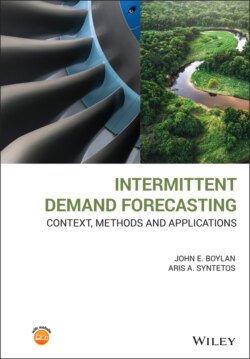Читать книгу Intermittent Demand Forecasting - John E. Boylan - Страница 10
Preface
ОглавлениеThe images on the front of this book highlight a crucial tension for all advanced economies. There is a desire to travel more and consume more, but also a growing awareness of the detrimental effects that this is having on the environment. There is a belated realisation that those of us living in countries with developed economies need to consume less and waste less.
Waste can occur at all stages of the supply chain. Consumers may buy food they never eat or clothes they never wear. Retailers and wholesalers may order goods from manufacturers that never sell. These wastages can be significantly reduced by better demand forecasting and inventory management. Some items conform to regular demand patterns and are relatively easy to forecast. Other items, with irregular and intermittent demand patterns, are much harder.
Wastage can be addressed by changes in production, moving away from built‐in obsolescence and towards products that can be maintained and repaired economically. For this to be an attractive proposition, spare parts need to be readily available. Unfortunately, these items are often the most difficult to forecast because many of them are subject to the sporadic nature of intermittent demand. Although there have been significant advances in intermittent demand forecasting over recent decades, these are not all available in commercial software. In the final chapter of this book, we highlight the progress that has been made, including methods that are freely available in open source software.
The reasons for the slow adoption of new forecasting methods and approaches in commercial software are varied. We believe that one of the reasons is a lack of appreciation of the benefits that may accrue. Because intermittent demand items are so difficult to forecast, it may be thought that highly accurate forecasting methods can never be found. This may be true. However, it is possible to find more accurate methods, which can contribute towards significant improvements in inventory management.
There is also a need for greater awareness of the methods that have been developed in recent years. Information on them is scattered amongst a variety of academic journals, and some of the articles are highly technical. Therefore, we have set ourselves the challenge of synthesizing this body of knowledge. We have endeavoured to bring together the main strands of research into a coherent whole, and assuming no prior knowledge of the subject.
There are various perspectives from which demand forecasting can be addressed. One option would be to take an operations management view, with a focus on forecasting and planning processes. Another would be to take a more statistical perspective, starting with mathematical models and working through their properties. While some of our material has been influenced by these orientations, the dominant perspective of this book is that of operational research (OR). The start point of OR should always be the real‐life situation that is encountered. This means that it is essential to gain an in‐depth understanding of inventory systems and how forecasts inform these decisions. Such an appreciation enables a sharper focus on forecasting requirements and the appropriate criteria for a ‘good forecast’.
In this book, the first three chapters focus on the inventory management context in which forecasting occurs, including the inventory policies and the service level measures that are appropriate for intermittent demand. Recognising the interconnection between inventory policies, demand distributions, and forecasting methods, the next two chapters focus on demand distributions, including evidence from studies of real‐world data. The following two chapters concentrate on forecasting methods, with discussion of practical issues that must be addressed in their implementation. We then turn to the linkage between forecasts and inventory availability, and review how forecast accuracy should be measured and how its implications for inventories should be assessed. We also look at how stock keeping units should be classified for forecasting purposes, and examine methods designed specifically to address maintenance and obsolescence. The next two chapters deal with methods that can tackle more challenging demand patterns. We conclude with a review of forecasting software requirements and our views on the way forward.
We are grateful to those pioneers who inspired us to study this subject, and who have given us valuable advice over the years, especially John Croston, Roy Johnston, and Tom Willemain. We would like to express our thanks to those who commented on draft chapters of this book: Zied Babai, Stephen Disney, Robert Fildes, Thanos Goltsos, Matteo Kalchschmidt, Stephan Kolassa, Nikos Kourentzes, Mona Mohammadipour, Erica Pastore, Fotios Petropoulos, Dennis Prak, Anna‐Lena Sachs, and Ivan Svetunkov; and to Nicole Ayiomamitou and Antonis Siakallis who helped with the figures.
Lancaster and Cardiff
January 2021
John E. Boylan
Aris A. Syntetos
